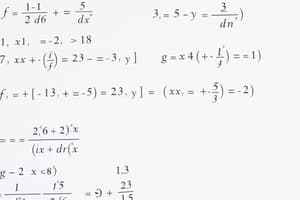Podcast
Questions and Answers
What is a RELATION in mathematics?
What is a RELATION in mathematics?
- A set of ordered pairs (x,y) (correct)
- A function that is not defined
- A single value pair (x,y)
- Any random collection of numbers
Which of the following correctly defines the DOMAIN of a relation?
Which of the following correctly defines the DOMAIN of a relation?
- The set of all numerical outputs
- The set of all Y-components of the ordered pairs
- The set of all X-components of the ordered pairs (correct)
- The set of all ordered pairs
Which of these is an example of a function?
Which of these is an example of a function?
- {(1,1), (1,1), (1,1)}
- {(1,1), (2,2), (3,3)} (correct)
- {(1,2), (2,3), (2,4)}
- {(1,0), (0,1), (0,-1)}
What does the vertical line test determine?
What does the vertical line test determine?
What is the RANGE of the relation {(1,3), (2,4), (5,6), (7,8)}?
What is the RANGE of the relation {(1,3), (2,4), (5,6), (7,8)}?
Which ordered pair confirms that a relation is NOT a function?
Which ordered pair confirms that a relation is NOT a function?
What type of mapping indicates many-to-one relationships?
What type of mapping indicates many-to-one relationships?
How are functions and relations different?
How are functions and relations different?
Flashcards are hidden until you start studying
Study Notes
Functions and Relations
- A relation is a set of ordered pairs (x, y).
- The domain consists of all x-components (independent variable).
- The range consists of all y-components (dependent variable).
Ordered Pairs Example
- Given ordered pairs {(1,3), (2,4), (5,6), (7,8)}:
- Domain: {1, 2, 5, 7}
- Range: {3, 4, 6, 8}
- Given ordered pairs {(-2,1), (0,-1), (5,3), (0,7)}:
- Domain: {-2, 0, 5}
- Range: {1, -1, 3, 7}
Definition of a Function
- A function establishes a relationship where each x-value corresponds to exactly one y-value.
Representations of Functions
-
Mapping (one-to-one):
- Each domain x maps to one unique range y.
- Example:
- Domain (x): 1, 3, 5, 7
- Range (y): 2, 4, 6, 8
-
Mapping (one-to-many):
- A single domain x can map to multiple y-values.
- Example:
- Domain (x): 2, 5, 7
- Range (y): 3, 4, 6, 8
-
Mapping (many-to-one):
- Multiple domain x-values can correspond to a single range y-value.
- Example:
- Domain (x): 2, 3, 4, 6
- Range (y): 5, 7, 8
Function Identification
- To determine if a set is a function, a vertical line test can be applied on its graph:
- A relation is a function if any vertical line intersects the graph at only one point.
Function Examples
- Example of a function: {(1,1), (2,2), (3,3), (4,4)}
- Example of a non-function: {(1,0), (0,1), (-1,0), (0,-1)}
Tables of Values
- Functions can be presented in tabular format.
- Example table with values:
- x: 1, 2, 3, 4
- y: 20, 40, 60, 80
Summary
- All functions are relations, but not all relations are functions.
- Understanding the distinction between functions and relations is essential for further mathematical concepts.
Studying That Suits You
Use AI to generate personalized quizzes and flashcards to suit your learning preferences.




